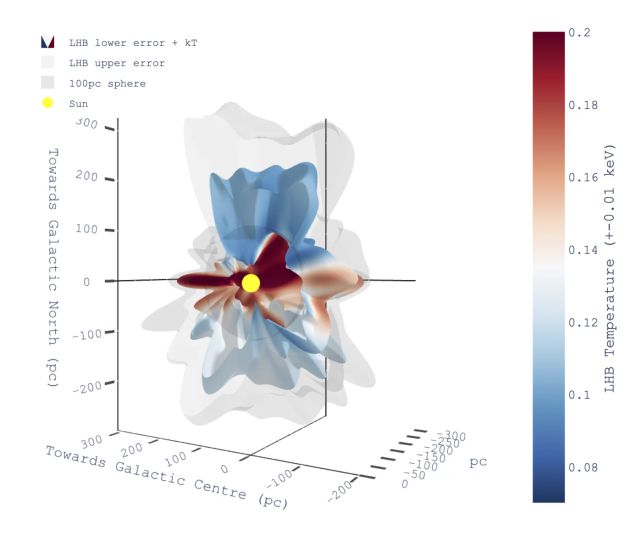The Photo voltaic System’s little pocket of the Milky Method is, apparently sufficient, precisely that. Our star resides in an unusually scorching, low-density compartment within the galaxy’s skirts, often known as the Native Sizzling Bubble (LHB).
Why it is not referred to as the Native Sizzling Pocket is anybody’s guess; however, as a result of it is an anomaly, scientists need to know why the area exists.
Now a group of astronomers has mapped the bubble, revealing not only a unusual asymmetry within the pocket’s form and temperature gradient, however the presence of a mysterious tunnel pointing in the direction of the constellation Centaurus.
The brand new knowledge concerning the form and warmth of the bubble helps a earlier interpretation that the LHB was excavated by exploding supernovae that expanded and heated the construction, whereas the tunnel means that it might be linked to a different low-density bubble close by.
The LHB is characterised by its temperature. It is a area regarded as a minimum of 1,000 light-years throughout, hovering at a temperature of round 1,000,000 Kelvin. As a result of the atoms are unfold so skinny, this excessive temperature would not have a major heating impact on the matter inside, which might be simply as effectively for us. However it does emit a glow in X-rays, which is how astronomers recognized it, years in the past.
However characterizing one thing you are bodily inside is quite a bit simpler to say than do. Think about a fish (if a fish had human-like intelligence) making an attempt to explain the form of its tank with out shifting from the middle. It is tough – however with the fitting instruments, it turns into simpler.
This brings us to eROSITA, the Max Planck Institute of Extraterrestrial Physics’ highly effective space-based X-ray telescope. Led by astrophysicist Michael Yeung of the Institute, a group of researchers has made use of eROSITA to probe the LHB in higher element than ever earlier than.
We all know, due to earlier analysis efforts, that the LHB was probably the product of supernova explosions going off like a string of firecrackers, some 14.4 million years in the past. The Photo voltaic System’s place within the bubble’s middle is only a enjoyable cosmic coincidence. However the LHB’s form remained poorly-defined – a type of blobby, chubby knucklebone-like configuration.
frameborder=”0″ enable=”accelerometer; autoplay; clipboard-write; encrypted-media; gyroscope; picture-in-picture; web-share” referrerpolicy=”strict-origin-when-cross-origin” allowfullscreen>
One huge benefit of eROSITA is its place. Wisps of our planet’s environment attain a shocking distance into area, with a big halo of hydrogen often known as the geocorona extending so far as 100 Earth radii – over 600,000 kilometers (greater than 370,000 miles) – from the floor. When particles blowing from the Solar work together with the geocorona, they create a diffuse X-ray glow similar to the glow of the LHB.
eROSITA is aboard a area observatory positioned some 1.5 million kilometers from Earth. Sitting in a gravitationally steady place created by Earth’s and the Solar’s pull, the X-ray observatory is the primary of its sort to look at the X-ray sky from utterly exterior of our glowing geocorona.
The researchers divided up eROSITA observations of the X-ray sky into round 2,000 sections, and painstakingly studied the X-ray gentle in every to generate a map of the LHB. Their findings revealed that the bubble is increasing perpendicular to the galactic airplane, greater than in a parallel route. This isn’t sudden, for the reason that vertical instructions provide much less resistance than the horizontal.

The asymmetrical temperature gradient the researchers measured was in keeping with the supernova concept for the bubble’s creation, with the likelihood that stars had been exploding in our neighborhood till just some million years in the past.
Their map additionally refined the recognized form of the LHB, permitting for a mannequin to be constructed in three dimensions. The outcome resembles the outflows of what is often known as a bipolar nebula, if just a little spikier and bumpier. And there was a hidden shock.
“What we did not know was the existence of an interstellar tunnel in the direction of Centaurus, which carves a niche within the cooler interstellar medium,” says astrophysicist Michael Freyberg of the Max Planck Institute for Extraterrestrial Physics. “This area stands out in stark aid.”
We do not know, but, what the tunnel connects to. There are a selection of objects within the route it trails off in, together with the Gum nebula, one other neighboring bubble, and a number of other molecular clouds.
It is also a clue that the galaxy consists of a complete linked community of scorching bubbles and interstellar tunnels, an concept proposed in 1974, and for which little proof has but emerged. We may be on the point of discovering that community now – and this, in flip, might assist us study extra concerning the latest historical past of our galaxy.
The analysis has been revealed in Astronomy & Astrophysics.





